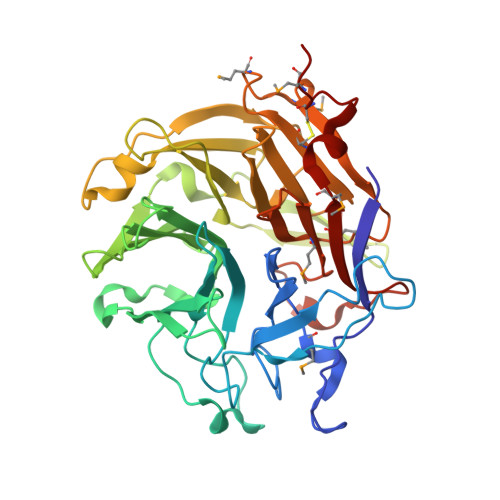Structure and function of a "yellow" protein from saliva of the sand fly Lutzomyia longipalpis that confers protective immunity against Leishmania major infection.
Xu, X., Oliveira, F., Chang, B.W., Collin, N., Gomes, R., Teixeira, C., Reynoso, D., My Pham, V., Elnaiem, D.E., Kamhawi, S., Ribeiro, J.M., Valenzuela, J.G., Andersen, J.F.(2011) J Biol Chem 286: 32383-32393
- PubMed: 21795673
- DOI: https://doi.org/10.1074/jbc.M111.268904
- Primary Citation of Related Structures:
3Q6K, 3Q6P, 3Q6T - PubMed Abstract:
LJM11, an abundant salivary protein from the sand fly Lutzomyia longipalpis, belongs to the insect "yellow" family of proteins. In this study, we immunized mice with 17 plasmids encoding L. longiplapis salivary proteins and demonstrated that LJM11 confers protective immunity against Leishmania major infection. This protection correlates with a strong induction of a delayed type hypersensitivity (DTH) response following exposure to L. longipalpis saliva. Additionally, splenocytes of exposed mice produce IFN-γ upon stimulation with LJM11, demonstrating the systemic induction of Th1 immunity by this protein. In contrast to LJM11, LJM111, another yellow protein from L. longipalpis saliva, does not produce a DTH response in these mice, suggesting that structural or functional features specific to LJM11 are important for the induction of a robust DTH response. To examine these features, we used calorimetric analysis to probe a possible ligand binding function for the salivary yellow proteins. LJM11, LJM111, and LJM17 all acted as high affinity binders of prohemostatic and proinflammatory biogenic amines, particularly serotonin, catecholamines, and histamine. We also determined the crystal structure of LJM11, revealing a six-bladed β-propeller fold with a single ligand binding pocket located in the central part of the propeller structure on one face of the molecule. A hypothetical model of LJM11 suggests a positive electrostatic potential on the face containing entry to the ligand binding pocket, whereas LJM111 is negative to neutral over its entire surface. This may be the reason for differences in antigenicity between the two proteins.
Organizational Affiliation:
Laboratory of Malaria and Vector Research, NIAID, National Institutes of Health, Rockville, Maryland 20852, USA.
















